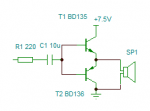Andres Rodriguez
New Member
I am trying to drive a speaker with the output of a Picaxe. I would prefer to use 7.4V and would appreciate commens and/or suggestions regarding the attached schematic.
View attachment Speaker connection.pdf
View attachment Speaker connection.pdf

